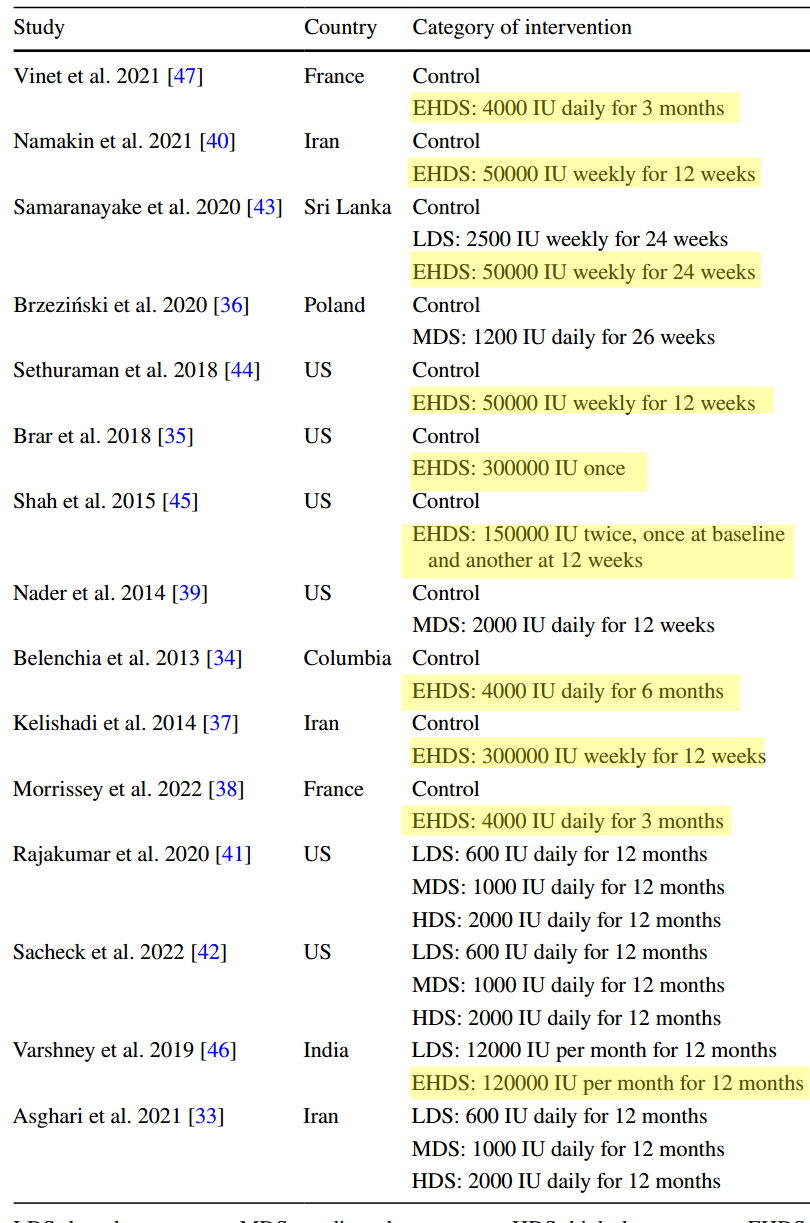High-dose Vitamin D reduced inflammation and insulin resistance (obese children)
Optimal vitamin D supplement dosage for improving insulin resistance in children and adolescents with overweight/obesity: a systematic review and network meta-analysis
Eur J Nutr . 2023 Dec 30. doi: 10.1007/s00394-023-03301-x
Linlian Zhu # 1, Shan Li # 2, Lijuan Zhong 3, Shiping Xu 4, Hongbin Zhu 5
EHDS = Extremely High D Supplementation
MHDS = Medium D Supplementation



Purpose: We conducted a network meta-analysis which aims to evaluate the comparative efficacy of different supplementation dosages of vitamin D on cardiometabolic and bone-metabolic indicators as well as insulin resistance in children and adolescents with overweight/obesity.
Methods: Eligible studies published before December 10, 2022 were retrieved from PubMed, EMBASE, Cochrane Library, and Web of Science. Mean difference and 95% confidence interval (CI) were used to express pooled estimates. Network meta-analysis of multiple doses, including low (< 1000 IU/day, LDS), medium (1000-2000 IU/day, MDS), high (2000-4000 IU/day, HDS), and extremely high (> 4000 IU/day, EHDS) dosage strategy, was conducted using STATA/MP 14.0.
Results: Our network meta-analysis of 15 RCTs suggested that, compared with placebo and LDS, EHDS was increased 25-(OH)-D, with a pooled MD of 8.65 (95% CI 4.72-12.58) and 7.66 (95% CI 0.91-14.41), respectively. Meanwhile, EHDS also decreased ho meostasis model assessment-insulin resistance (HOMA-IR) (MD: - 0.74; 95% CI: - 1.45 to - 0.04) and C-reactive protein (CRP) (MD: - 18.99; 95% CI - 21.60 to - 16.38), and EHDS was also better than LDS (MD: - 18.47; 95% CI - 20.66 to - 16.28) and MDS (MD: - 19.69; 95% CI - 22.17 to - 17.21) in decreasing CRP. Ranking probability suggested that EHDS ranked best for increasing 25-(OH)-D, and decreasing HOMA-IR and CRP, with a probability of 86.1%, 83.1%, and 76.6%, respectively.
Conclusions: The results of our network meta-analysis suggest that EHDS may be the best strategy for vitamin D supplementation to reduce inflammatory responses as well as improve insulin resistance in children and adolescents with overweight/obesity.
📄 Download the PDF from VitaminDWiki
Most RCTs found that Vitamin D reduced glucose intolerance in obese children - Jan 2024
Vitamin D intervention as a curative measure for glucose intolerance in obese children and adolescents: a systematic review on randomized control trials
Eur J Pediatr. 2024 Jan 11. doi: 10.1007/s00431-023-05407-0
Ayushi Singh 1, Neetu Singh 2
Vitamin D deficiency is associated with obesity and its associated metabolic disorders, as specified in many epidemiological studies. The assertion that vitamin D can mitigate insulin insensitivity in obese children and adolescents lacks adequate empirical substantiation. Thus, the study utilized some clinical trials on vitamin D interventions to examine the impact of vitamin D supplementation on insulin resistance in obese children and adolescents. The literature was extracted by applying the PRISMA method through electronic databases such as Scopus, Science Direct, Medline, the Cochrane Library, and PubMed from 2012 to 2022. All the articles were in English, and the inclusion criteria for each article were based on the study design and the anthropometric and biochemical parameters of the subjects. A total of 572 research articles were acquired, out of which only seven closely adhered to the inclusion criteria of the study. The studies in this systematic review are based on randomized control trials. The age range of the children in this study spans from 2 to 19 years, and the follow-up period ranges from 3 to 12 months. The range of daily vitamin D doses provided varied from 2000 to 10,000 IU. The results indicate that four randomized controlled trials have demonstrated a positive impact on glycemic parameters, such as insulin levels, fasting blood sugar, and insulin resistance, in the subjects following vitamin D treatment. However, the three trials did not provide sufficient evidence to support a statistically significant effect.
Conclusion: The present review highlights that a significant proportion of the studies incorporated in the analysis demonstrate that the administration of vitamin D may be a preventive measure in ameliorating insulin resistance among pediatric patients with obesity, but it is advisable to implement a prolonged intervention with a substantial sample size and perform micro-level analysis at the gene level to evaluate the impact of vitamin D treatment.
What is known:
Childhood obesity and its associated metabolic disorder is a concerned global problem.
Several studies showed an association of vitamin D deficiency with adiposity- induced metabolic disorders which are still controversial. This study focused on finding interlink between vitamin D supplementation with obesity induced insulin resistance in children and adolescents.
What is new:
This study supports that high dosage of Vitamin D in long term may be protective against insulin resistance in obese paediatric individuals.
A new factor is also reported in the study that vitamin D may alter the composition of gut microbiota which represents a compelling approach to the therapeutic management of obesity and diabetes.
